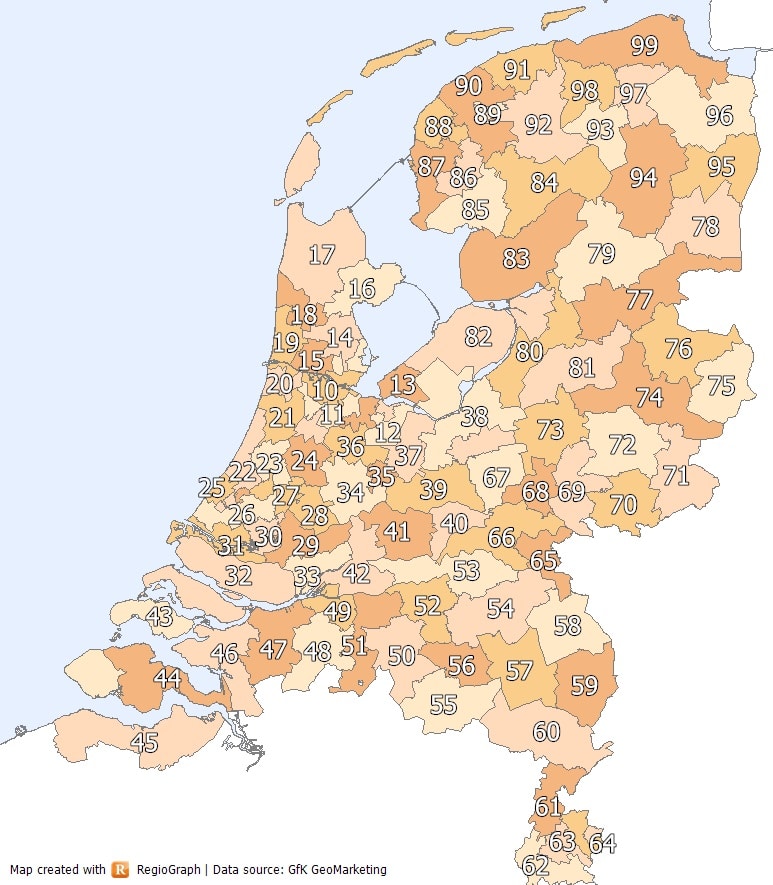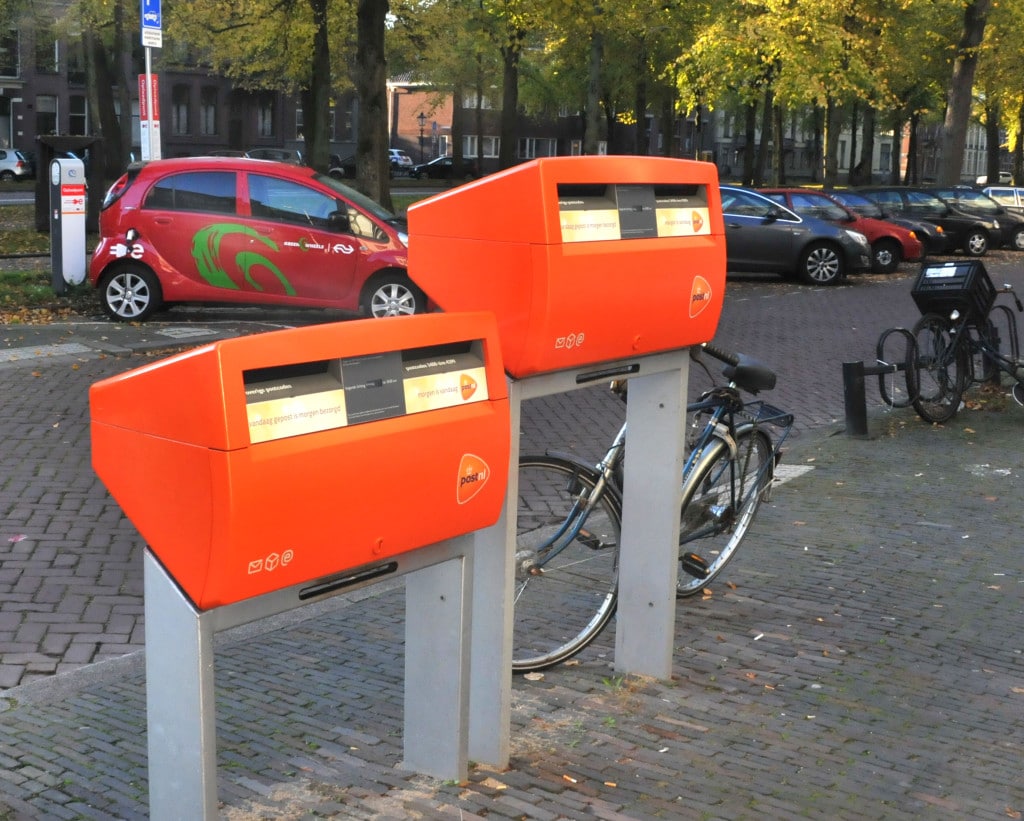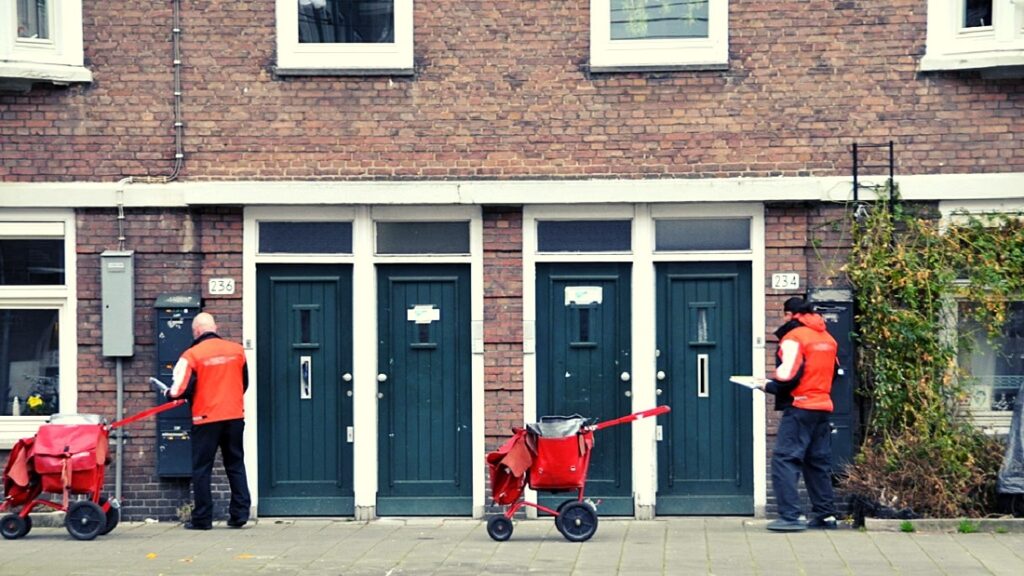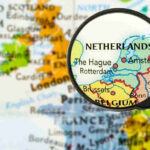The basics of Dutch addresses
A Dutch address consists of a street name, house number, postal code, and the name of the town/city. To send something to a person in the Netherlands, write down the recipient’s name on the first line, the street name and house number on the second line, the postal code and town/city on the third line, and “The Netherlands” on the fourth line.
Here’s an example:
Emma Bakker
Kerkstraat 462
1017 HZ Amsterdam
The Netherlands
In this example, the street name is “Kerkstraat.” Many Dutch street names end in “straat,” “laan,” or “weg.” They’re the Dutch words for “street,” “lane,” and “way” (“way” is used in a more literal sense in Dutch).
Most house numbers only consist of digits, like the number 462 in this example. But in some cases, the house number has a suffix. Instead of a family living on “Kerkstraat 462,” you might have one family living on “Kerkstraat 462a,” another living on “Kerkstraat 462b,” and so on. So, if there’s a suffix, make sure you include it. In extremely rare cases, multiple letters refer to a single house, so the address might be “Kerkstraat 462a-c.”
The postal code in this example is “1017 HZ.” Dutch postal codes all follow the same format: four digits followed by two capital letters. Officially, you’re supposed to leave a space between the digits and the letters, but it will be delivered just the same if you don’t.
If you want to send something to someone in the Netherlands but don’t know the postal code, you can look it up If you want to send something to someone in the Netherlands but don’t know the postal code, you can look it up here.
When it comes to the name of the town or city, you have the choice to capitalize the first letter or every letter. So, in this example, “Amsterdam” or “AMSTERDAM.” It doesn’t affect delivery, but professional organizations generally write the town/city in all caps.
I’ve included “The Netherlands” in this example address because the post office needs to know that your envelope or package has to go to the Netherlands. Of course, if you’re sending it from within the Netherlands, then you don’t need to include it.
A post office box instead of a street
Just like in other countries, some individuals and organizations use post office boxes. When you send something to a post office box, there’s no street name. Instead of a street name, you write down the word “postbus” (the Dutch word for “post office box”) and the number of the post office box. For example:
Emma Bakker
Postbus 12345
1017 HZ Amsterdam
The Netherlands
Post office box numbers vary in length from one to five digits. So, don’t be surprised if you encounter a post office box number shorter than the one in this example.
Some organizations use a specific type of post office box called an “antwoordnummer” (answer number). These work exactly the same way as regular post office boxes, except that you don’t need to pay for postage if you’re the sender. All costs are covered by the receiver. When you send something to an “antwoordnummer,” you write “antwoordnummer” instead of “postbus.”
How Dutch postal codes work
The Dutch postal code system is well thought out. Let me break it down for you.
The system divides the country into nine regions. The first digit of the postal code indicates in which region an address is located. This map shows the regions and corresponding first digits:
Each region is further divided into subregions. So, now we got two digits:

After that, each subregion is divided even further. That’s where the third and fourth digit come in. The four digits together don’t just tell you in which town an address is located, they usually even tell you which part of town. The two letters then actually narrow it down to a street name, or sometimes part of a street or part of two streets.
This means that the postal code and the house number alone tell you exactly where someone lives. That’s why, if you order something online in the Netherlands, websites generally just ask you to type in your postal code and house number and then automatically fill out your town and street name.
So, the only reason you need to include the town and street name when you send something in the mail is to make sure human errors can’t get in the way of delivery. You’re basically providing the same information twice, so the post office can still figure out what you mean if you make a mistake. And mailmen are less likely to misread a street name than a postal code.
The effectiveness of Dutch postal codes is the reason provinces aren’t included in Dutch addresses. It would simply be redundant.
Two interesting Dutch postal code facts
While we’re on the topic, there are two facts about the Dutch postal code system that are worth mentioning.
The first fact is about WWII. The Netherlands was occupied by Nazi Germany during the war, and the Nazis had a paramilitary organization called the “Schutzstaffel” (abbreviated as SS), another one called the “Sturmabteilung” (SA), and an intelligence agency called the “Sicherheitsdienst” (SD). Because Dutch people associated these letter combinations with the Nazis, they have been intentionally left out of the Dutch postal code system.
The second fact is that the “Nationale Postcode Loterij” (the National Postal Code Lottery) is the biggest lottery in the Netherlands. Reportedly, this lottery has 3 million participants, which is quite a lot in a country with only 8 million households.
The reason so many people participate in this lottery is fear of missing out. In a regular lottery, if you don’t buy a lottery ticket, you never know if you would have won if you had bought one. In the Postal Code Lottery, however, your lottery number is your postal code. So, if you don’t buy a ticket, and your postal code wins, you’re still going to hear about it, and you will know for certain that you would have won if you had played. And if that isn’t bad enough, everyone else will know too, especially your neighbors who are out celebrating because they did buy tickets. So, many people participate in the lottery just to avoid this scenario.
Practical tips for when you’re in the Netherlands
If you’re in the Netherlands and you want to send something in the mail, the process is pretty straightforward.
You can buy envelopes and stamps in supermarkets and many other stores. Envelopes are called “enveloppen” and stamps are called “postzegels” in Dutch. Most Dutch store employees will also understand you if you ask them in English, though.
Once you’ve put your stamps on the envelopes, written down the addresses, and you’re all set to use the Dutch postal system, you can simply push the envelopes into one of the orange PostNL roadside mailboxes that you can find all over the country. They look like this:

Be sure to use the mailbox for tall people if you want to get the authentic Dutch experience.
Most mailboxes have two slots. One is for regional mail, underneath that one will be a range of postal codes (“postcodes” in Dutch). If the postal code of the address you’re sending to falls outside of that range, use the other one. That one will have “overige postcodes” written underneath, it means “other postal codes.”
If you can’t find a roadside mailbox, visit the English version of the official PostNL website and click on “find your PostNL point.” You can also use that to find a post office or drop-off location, in case you want to send a parcel.
When it comes to sending parcels, both domestically and internationally, PostNL is reliable and gets the job done. They’re not your only option, however. Other organizations that are specialized in parcels, like DHL, also operate in the Netherlands.


